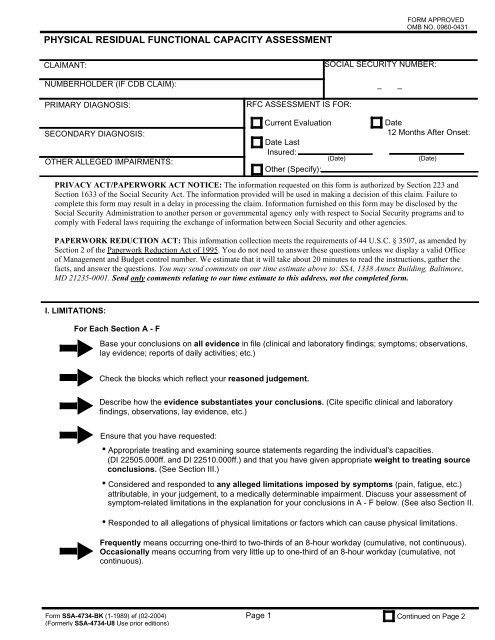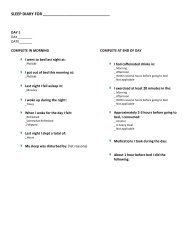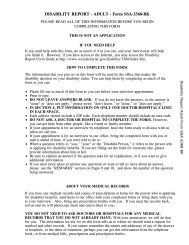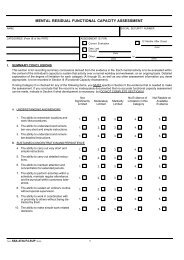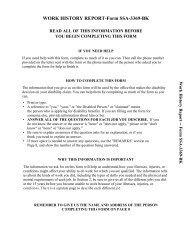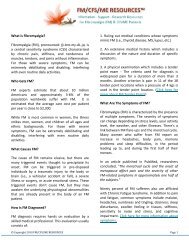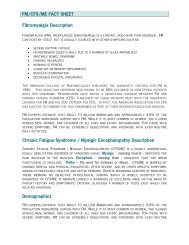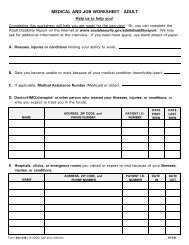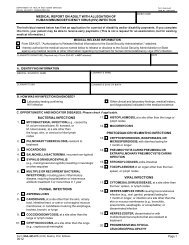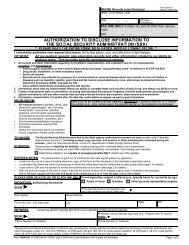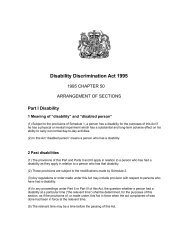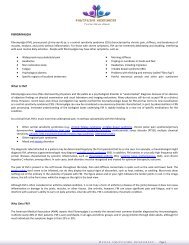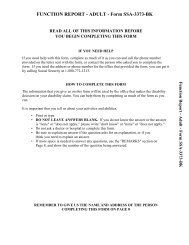physical residual functional capacity assessment - FM/CFS/ME ...
physical residual functional capacity assessment - FM/CFS/ME ...
physical residual functional capacity assessment - FM/CFS/ME ...
You also want an ePaper? Increase the reach of your titles
YUMPU automatically turns print PDFs into web optimized ePapers that Google loves.
PHYSICAL RESIDUAL FUNCTIONAL CAPACITY ASSESS<strong>ME</strong>NT<br />
FORM APPROVED<br />
OMB NO. 0960-0431<br />
CLAIMANT:<br />
NUMBERHOLDER (IF CDB CLAIM):<br />
PRIMARY DIAGNOSIS:<br />
RFC ASSESS<strong>ME</strong>NT IS FOR:<br />
SOCIAL SECURITY NUMBER:<br />
– –<br />
SECONDARY DIAGNOSIS:<br />
OTHER ALLEGED IMPAIR<strong>ME</strong>NTS:<br />
Current Evaluation<br />
Date Last<br />
Insured:<br />
Other (Specify):<br />
(Date)<br />
Date<br />
12 Months After Onset:<br />
(Date)<br />
PRIVACY ACT/PAPERWORK ACT NOTICE: The information requested on this form is authorized by Section 223 and<br />
Section 1633 of the Social Security Act. The information provided will be used in making a decision of this claim. Failure to<br />
complete this form may result in a delay in processing the claim. Information furnished on this form may be disclosed by the<br />
Social Security Administration to another person or governmental agency only with respect to Social Security programs and to<br />
comply with Federal laws requiring the exchange of information between Social Security and other agencies.<br />
PAPERWORK REDUCTION ACT: This information collection meets the requirements of 44 U.S.C. § 3507, as amended by<br />
Section 2 of the Paperwork Reduction Act of 1995. You do not need to answer these questions unless we display a valid Office<br />
of Management and Budget control number. We estimate that it will take about 20 minutes to read the instructions, gather the<br />
facts, and answer the questions. You may send comments on our time estimate above to: SSA, 1338 Annex Building, Baltimore,<br />
MD 21235-0001. Send only comments relating to our time estimate to this address, not the completed form.<br />
I. LIMITATIONS:<br />
For Each Section A - F<br />
<br />
<br />
<br />
<br />
<br />
Base your conclusions on all evidence in file (clinical and laboratory findings; symptoms; observations,<br />
lay evidence; reports of daily activities; etc.)<br />
Check the blocks which reflect your reasoned judgement.<br />
Describe how the evidence substantiates your conclusions. (Cite specific clinical and laboratory<br />
findings, observations, lay evidence, etc.)<br />
Ensure that you have requested:<br />
•Appropriate treating and examining source statements regarding the individual's capacities.<br />
(DI 22505.000ff. and DI 22510.000ff.) and that you have given appropriate weight to treating source<br />
conclusions. (See Section III.)<br />
•Considered and responded to any alleged limitations imposed by symptoms (pain, fatigue, etc.)<br />
attributable, in your judgement, to a medically determinable impairment. Discuss your <strong>assessment</strong> of<br />
symptom-related limitations in the explanation for your conclusions in A - F below. (See also Section II.<br />
•Responded to all allegations of <strong>physical</strong> limitations or factors which can cause <strong>physical</strong> limitations.<br />
Frequently means occurring one-third to two-thirds of an 8-hour workday (cumulative, not continuous).<br />
Occasionally means occurring from very little up to one-third of an 8-hour workday (cumulative, not<br />
continuous).<br />
Form SSA-4734-BK (1-1989) ef (02-2004)<br />
(Formerly SSA-4734-U8 Use prior editions)<br />
Page 1<br />
Continued on Page 2
A. EXERTIONAL LIMITATIONS<br />
None established. (Proceed to section B.)<br />
1. Occasionally lift and/or carry (including upward pulling)<br />
(maximum) - when less than one-third of the time or less than 10 pounds, explain the amount (time/pounds) in item 6.<br />
less than 10 pounds<br />
10 pounds<br />
20 pounds<br />
50 pounds<br />
100 pounds or more<br />
2. Frequently lift and/or carry (including upward pulling)<br />
(maximum) - when less than two-thirds of the time or less than 10 pounds, explain the amount (time/pounds) in item 6.<br />
less than 10 pounds<br />
10 pounds<br />
25 pounds<br />
50 pounds or more<br />
3. Stand and/or walk (with normal breaks) for a total of -<br />
less than 2 hours in an 8-hour workday<br />
at least 2 hours in an 8-hour workday<br />
about 6 hours in an 8-hour workday<br />
medically required hand-held assistive device is necessary for ambulation<br />
4. Sit (with normal breaks) for a total of -<br />
less than about 6 hours in an 8-hour workday<br />
about 6 hours in an 8-hour workday<br />
must periodically alternate sitting and standing to relieve pain or discomfort. (If checked, explain in 6.)<br />
5. Push and/or pull (including operation of hand and/or foot controls) -<br />
unlimited, other than as shown for lift and/or carry<br />
limited in upper extremities (describe nature and degree)<br />
limited in lower extremities (describe nature and degree)<br />
6. Explain how and why the evidence supports your conclusions in item 1 through 5.<br />
Cite the specific facts upon which your conclusions are based.<br />
Form SSA-4734-BK (1-1989) ef (02-2004)<br />
Page 2<br />
Continued on Page 3
6. Continue (NOTE: MAKE ADDITIONAL COM<strong>ME</strong>NTS IN SECTION IV)<br />
B. POSTURAL LIMITATIONS<br />
None established. (Proceed to section C.)<br />
1. Climbing - ramp/stairs<br />
- ladder/rope/scaffolds<br />
2. Balancing<br />
3. Stooping<br />
4. Kneeling<br />
5. Crouching<br />
6. Crawling<br />
Frequently<br />
Occasionally<br />
7. When less than two-thirds of the time for frequently or less than one-third for occasionally, fully describe and<br />
explain. Also explain how and why the evidence supports your conclusions in items 1 through 6. Cite the<br />
specific facts upon which your conclusions are based.<br />
<br />
<br />
<br />
<br />
<br />
<br />
Never<br />
Form SSA-4734-BK (1-1989) ef (02-2004)<br />
Page 3<br />
Continued on Page 4
C. MANIPULATIVE LIMITATIONS<br />
None established. (Proceed to section D.)<br />
LIMITED<br />
UNLIMITED<br />
1. Reaching all directions (including overhead)<br />
<br />
2. Handling (gross manipulation)<br />
<br />
3. Fingering (fine manipulation)<br />
<br />
4. Feeling (skin receptors)<br />
<br />
5. Describe how the activities checked ''limited'' are impaired. Also, explain how and why the evidence supports<br />
your conclusions in item 1 through 4. Cite the specific facts upon which your conclusions are based.<br />
D. VISUAL LIMITATIONS<br />
None established. (Proceed to section E.)<br />
LIMITED<br />
UNLIMITED<br />
1. Near acuity<br />
<br />
2. Far acuity<br />
<br />
3. Depth perception<br />
<br />
4. Accommodation<br />
<br />
5. Color vision<br />
<br />
6. Field of vision<br />
<br />
7. Describe how the faculties checked ''limited'' are impaired. Also explain how and why the evidence supports<br />
your conclusions it item 1 through 6. Cite the specific facts upon which your conclusions are based.<br />
Form SSA-4734-BK (1-1989) ef (02-2004)<br />
Page 4<br />
Continued on Page 5
E. COMMUNICATIVE LIMITATIONS<br />
None established. (Proceed to section F.)<br />
LIMITED<br />
UNLIMITED<br />
1. Hearing<br />
2. Speaking<br />
3. Describe how the faculties checked ''limited'' are impaired. Also, explain how and why the evidence supports<br />
your conclusions in items 1 and 2. Cite the specific facts upon which your conclusions are based.<br />
<br />
<br />
F. ENVIRON<strong>ME</strong>NTAL LIMITATIONS<br />
AVOID AVOID EVEN<br />
None established. (Proceed to section II.) CONCENTRATED MODERATE AVOID ALL<br />
UNLIMITED EXPOSURE EXPOSURE EXPOSURE<br />
1. Extreme cold<br />
2. Extreme heat<br />
3. Wetness<br />
4. Humidity<br />
5. Noise<br />
6. Vibration<br />
7. Fumes, odors,<br />
dusts, gases,<br />
poor ventilation,<br />
etc.<br />
8. Hazards<br />
(machinery,<br />
heights, etc.)<br />
<br />
<br />
<br />
<br />
<br />
<br />
<br />
9. Describe how these environmental factors impair activities<br />
and identify hazards to be avoided. Also, explain how<br />
and why the evidence supports your conclusions in items<br />
1 through 8. Cite the specific facts upon which your<br />
conclusions are based.<br />
<br />
Form SSA-4734-BK (1-1989) ef (02-2004)<br />
Page 5 Continued on Page 6
9. Continue (NOTE: MAKE ADDITIONAL COM<strong>ME</strong>NTS IN SECTION IV)<br />
II. SYMPTOMS<br />
For symptoms alleged by the claimant to produce <strong>physical</strong> limitations, and for which the following have not<br />
previously been addressed in section I, discuss whether:<br />
A. The symptom(s) is attributable, in your judgment, to a medically determinable impairment.<br />
B. The severity or duration of the symptom(s), in your judgment, is disproportionate to the expected severity or<br />
expected duration on the basis of the claimant's medically determinable impairment(s).<br />
C. The severity of the symptom(s) and its alleged effect on function is consistent, in your judgment, with the total<br />
medical and nonmedical evidence, including statements by the claimant and others, observations regarding<br />
activities of daily living, and alterations of usual behavior or habits.<br />
Form SSA-4734-BK (1-1989) ef (02-2004)<br />
Page 6 Continued on Page 7
III. TREATING OR EXAMINING SOURCE STATE<strong>ME</strong>NT(S)<br />
A. Is a treating or examining source statement(s) regarding the claimant's <strong>physical</strong> capacities in file?<br />
Yes<br />
No (includes situations in<br />
which there was no source<br />
or when the source(s) did<br />
not provide a statement<br />
regarding the! claimant's<br />
<strong>physical</strong> capacities.)<br />
B. If yes, are there treating/examining source conclusions about the claimant's limitations or restrictions which are<br />
significantly different from your findings?<br />
Yes<br />
No<br />
C. If yes, explain why those conclusions are not supported by the evidence in file. (Cite the source's name and the<br />
statement date.)<br />
Form SSA-4734-BK (1-1989) ef (02-2004)<br />
Page 7<br />
Continued on Page 8
IV. ADDITIONAL COM<strong>ME</strong>NTS:<br />
<strong>ME</strong>DICAL CONSULTANT'S SIGNATURE:<br />
<strong>ME</strong>DICAL CONSULTANT'S CODE: DATE:<br />
Form SSA-4734-BK (1-1989) ef (02-2004)<br />
Page 8


